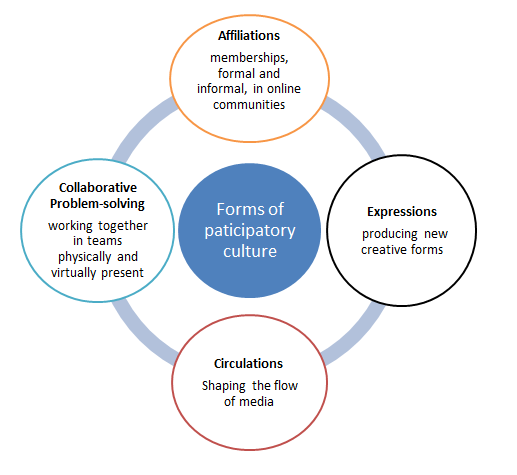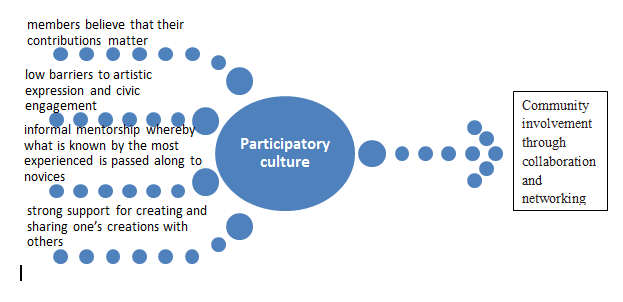Key words:
Brief summery:
In his article Jenkins presents topic on learning and technology (2009). Jenkins introduces new era of participatory culture. He states that “interactivity is a property of technology while participation is a property of culture” (8).
Each form of participatory culture contains opportunities for learning, creative expression, civic engagement, political empowerment, and economic advancement. Participatory culture makes people feel free to contribute, provides strong incentives for creative expression and active participation, and allows long-distance collaborations across different learning communities that are physically and virtually present.
Jenkins in his work introduces Gee’s ideas about affinity spaces, informal learning cultures (9). Gee compares affinity spaces and formal educational institutions. According to Gee (2004), people learn more, participate more actively, and engage more deeply with popular culture than they do with the contents of their textbooks. He describes affinity spaces as experimental, innovative, provisional, change with time, and localized while he describes formal institutions as conservative, static, institutional, little change, and national. More detailed description of his work can be found here.
According to Jenkins (2004), current tendency is that people acquire skills on their own. However, it presents certain obstacles such as participation gap, transparency problem, and ethics challenge (3). Therefore, it would be better for society if people acquire new skills with the help of professional educators; however, modern educational system requires dramatic changes and much more attention.
Work Cited
Jenkins, Henry. Confronting the Challenges of Participatory Culture: Media Education for the 21st Century. Cambridge, MA: The MIT Press, 2009. Print.
“Affinity space.” Wikipedia.Web 30 Aug. 2012.

Interactivity is a property of technology. Participation is a property of culture.
OLD MEDIA/NEW MEDIA
Old media includes newspapers, magazines, direct mail advertising, radio and television. Old media have limited number of old media producers, it is also limited geographically. Has one way communication. Producer if media has total control.
New media includes World Wide Web which has unlimited number of producers. It is not limited geographically – consumer only needs computer and internet access. Provides two-way communication. Producers have no control over what consumers say.
According to Gee (2004), old media reflects formal institutions which are conservative, static, institutional, little change, national. While new media which reflects affinity spaces (Informal learning environment) which are experimental, innovative, provisional, change with time, localized.


I just want to say I like how you explained new and old media you made it so easy to understand.